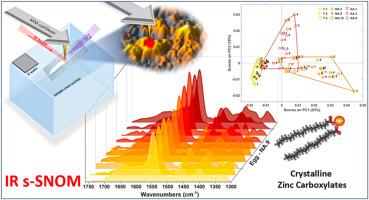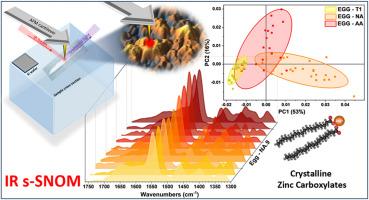石油和蛋彩画中羧酸锌形成的纳米形态和光谱映射
IF 6
2区 化学
Q1 CHEMISTRY, ANALYTICAL
引用次数: 0
摘要
本研究利用红外散射型扫描近场光学显微镜(IR - snom)在纳米尺度上分析锌白漆模型,重点研究锌羧酸盐的形成和结晶。羧酸锌是油画和蛋彩画中重要的降解产物,会导致脆性、分层和颜色变化。我们的研究将红外光谱s-SNOM应用于由油和鸡蛋粘合剂制备的油漆样品,经受自然和人工老化。结果使用化学计量学方法强调了环境条件和结合介质对样品间变异性的影响。值得注意的是,在人工老化下,羧酸锌在油粘合剂中形成得更快,而自然老化导致鸡蛋粘合剂中晶体结构更有序。虽然对单个IR s-SNOM光谱的分析并没有揭示纳米尺度上形态和化学之间的明确相关性,但它可以解开样品内部变异的原因。红外s-SNOM所保证的表面灵敏度是揭示微观方法所隐藏的光谱特征的关键因素,例如鉴定出卵子培养基中1700-1500 cm-1光谱区域的宽带,这是以前从未报道过的。本研究强调了纳米尺度分析在推进降解机制的理解方面可能发挥的关键作用,为艺术品保护提供了有价值的见解。通过从平均的整体分析过渡到纳米尺度的调查,IR - s-SNOM被证明是制定有针对性的保护策略的有力工具,最终加强了文化遗产的保护。本文章由计算机程序翻译,如有差异,请以英文原文为准。


Nanoscale morphological and spectroscopic mapping of zinc carboxylate formation in oil and tempera paintings
Background
This study explores the application of infrared scattering-type Scanning Near-field Optical Microscopy (IR s-SNOM) to analyze zinc white paint models at the nanoscale, focusing on the formation and crystallization of zinc carboxylates. Zinc carboxylates are critical degradation products in oil and tempera paintings, causing brittleness, delamination, and color changes. Our research applies IR s-SNOM to paint samples prepared with oil and egg binders, subjected to both natural and artificial aging.
Results
The impact of environmental conditions and binding mediums on inter-sample variability was highlighted using a chemometric approach. Notably, zinc carboxylates form more rapidly in oil binders under artificial aging, while natural ageing results in more ordered crystalline structures in egg binders. While the analysis of individual IR s-SNOM spectra did not reveal an unambiguous correlation between morphology and chemistry at the nanoscale, it allowed to disentangle the causes of intra-sample variability. The surface sensitivity guaranteed by IR s-SNOM was the key element for disclosing spectral features hidden by micro-approaches, such as the identification of the broad band in the 1700-1500 cm−1 spectral region in the egg medium, which had never been reported before.
Significance
This study highlights the critical role that nanoscale analysis may play in advancing the understanding of degradation mechanisms, offering valuable insights for art conservation. By transitioning from average, bulk analysis to nanoscale investigations, IR s-SNOM proved to be a powerful tool for developing targeted conservation strategies, ultimately enhancing the preservation of cultural heritage.
求助全文
通过发布文献求助,成功后即可免费获取论文全文。
去求助
来源期刊

Analytica Chimica Acta
化学-分析化学
CiteScore
10.40
自引率
6.50%
发文量
1081
审稿时长
38 days
期刊介绍:
Analytica Chimica Acta has an open access mirror journal Analytica Chimica Acta: X, sharing the same aims and scope, editorial team, submission system and rigorous peer review.
Analytica Chimica Acta provides a forum for the rapid publication of original research, and critical, comprehensive reviews dealing with all aspects of fundamental and applied modern analytical chemistry. The journal welcomes the submission of research papers which report studies concerning the development of new and significant analytical methodologies. In determining the suitability of submitted articles for publication, particular scrutiny will be placed on the degree of novelty and impact of the research and the extent to which it adds to the existing body of knowledge in analytical chemistry.
 求助内容:
求助内容: 应助结果提醒方式:
应助结果提醒方式:


